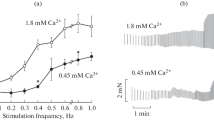Summary
o li]1.|In guinea-pig papillary muscle, the characteristic relation between force of contraction and frequency is changed by the withdrawal of magnesium from the incubation medium. In magnesium-free solution, reduction of contraction frequency below 0.1 Hz leads to an increase in force of contraction which reaches its maximum at a frequency of 0.00166 Hz (i.e., one contraction every 10 min).
After magnesium withdrawal, the frequency-force relationship in guinea-pig ventricular muscle resembles that of guinea-pig atrial muscle in magnesium-containing solution. li]2.|The increase by magnesium withdrawal in contractile force of guinea-pig papillary muscles contracting at low frequencies is the result of an increase in contraction velocity. The time to peak force is shortened and the relaxation time is prolonged. li]3.|After obtaining steady-state values of contractile force at 1 Hz contraction frequency, stimulation was terminated and the time course of changes in the inherent contractile activity of the muscle was determined by eliciting single contractions at time intervals of between 0.5 and 10 min duration.
After cessation of stimulation, the contractile activity declines exponentially in solution containing 1.2 mM Mg2+; in magnesium-free solution an initial decline is followed by a slowly developing increase. This rise in contractile activity is reduced at 3.2 mM Ca2+ by the presence of 0.075 mM Mg2+ and is prevented by 0.3 mM Mg2+. li]4.|The increase in contractile activity obtained in the papillary muscle during rest by magnesium withdrawal depends in its magnitude on [Ca2+]0. li]5.|The rested-state contractile activity of ventricular muscle in magnesium-free solution is reduced by 75% with the first and by 90% with the second contraction after onset of 1 Hz stimulation. li]6.|Possible mechanisms are discussed by which Mg2+ inhibits the development of rested-state contractile activity in the guinea-pig ventricular myocardium.
Similar content being viewed by others
References
Blinks, J. R., Koch-Weser, J.: Analysis of the effects of changes in rate and rhythm upon myocardial contractility. J. Pharmacol. exp. Ther. 134, 373–389 (1961)
Blinks, J. R., Koch-Weser, J.: Descriptive analysis of the interval-strength relationship of heart muscle. In: Proc. Int. Pharmacol. Meet., 2nd, Prague 1963, O. Krayer, ed., Vol. 5, pp. 53–62. Oxford: Pergamon Press 1964
Ford, L. E., Podolsky, R. J.: Intracellular calcium movements in skinned muscle fibres. J. Physiol. (Lond.) 223, 21–33 (1972)
Forester, G. V., Mainwood, G. W.: Interval dependent inotropic effects in the rat myocardium and the effect of calcium. Pflügers Arch. 352, 189–196 (1974)
Kruta, V., Stejskalová, J.: Allure de la contractilité et fréquence optimale du myocarde auriculaire chez quelques mammifères. Arch. int. Physiol. Biochim. 68, 152–164 (1960)
Langer, G. A.: Calcium exchange in dog ventricular muscle: Relation to frequency of contraction and maintenance of contractility. Circulat. Res. 17, 78–89 (1965)
Polimeni, P. I., Page, E.: Magnesium in heart muscle. Circulat. Res. 33, 367–374 (1973)
Reiter, M.: Der Einfluß der Natriumionen auf die Beziehung zwischen Frequenz und Kraft der Kontraktion des isolierten Meerschweinchenmyocards. Naunyn-Schmiedeberg's Arch. exp. Path. Pharmak. 254, 261–286 (1966)
Schatzmann, H. J.: Transmembrane calcium movements in resealed human red cells. In: Calcium and cellular function, A. W. Cuthbert, ed., pp. 85–95. London: Macmillan 1969
Shine, K. J., Douglas, A. M.: Magnesium effects on ionic exchange and mechanical function in rat ventricle. Amer. J. Physiol. 227, 317–324 (1974)
Vierling, W.: Influence of magnesium on the frequency-force relationship of cardiac ventricular muscle of the guinea pig. Naunyn-Schmiedeberg's Arch. Pharmacol. 282, R101 (1974)
Vierling, W., Reiter, M., Ebner, F.: The Ca-Mg antagonism on the contractility of the guinea-pig papillary muscle in dependence on the sodium concentration. Naunyn-Schmiedeberg's Arch. Pharmacol. 274, R120 (1972)
Weber, A.: The mechanism of the action of caffeine on sarcoplasmic reticulum. J. gen. Physiol. 52, 760–772 (1968)
Ziehm, E.: Die Wirkungen von Änderungen der Reizfrequenz und der Ca++-Ionen-konzentration in der Außenlösung auf die isometrische Kontraktion und das Aktionspotential am Meerschweinchenvorhof. Inaugural-Dissertation, Technische Universität München, Medizinische Fakultät (1972)
Author information
Authors and Affiliations
Rights and permissions
About this article
Cite this article
Vierling, W., Reiter, M. Frequency-force relationship in guinea-pig ventricular myocardium as influenced by magnesium. Naunyn-Schmiedeberg's Arch. Pharmacol. 289, 111–125 (1975). https://doi.org/10.1007/BF00501299
Received:
Accepted:
Issue Date:
DOI: https://doi.org/10.1007/BF00501299




